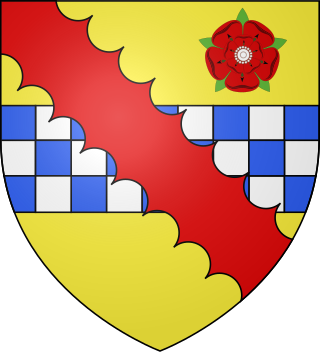Related Research Articles

The Lord Privy Seal is the fifth of the Great Officers of State in the United Kingdom, ranking beneath the Lord President of the Council and above the Lord Great Chamberlain. Originally, its holder was responsible for the monarch's personal (privy) seal until the use of such a seal became obsolete. Though one of the oldest offices in European governments, it has no particular function today because the use of a privy seal has been obsolete for centuries; it may be regarded as a traditional sinecure, but today, the holder of the office is invariably given a seat in the Cabinet of the United Kingdom, and is sometimes referred to as a minister without portfolio.

William Elphinstone was a Scottish statesman, Bishop of Aberdeen and founder of the University of Aberdeen.
William Turnbull was a Scottish politician and bishop, credited with founding Jedburgh Grammar School and the University of Glasgow. He served as the Bishop of Glasgow, from 1448 to 1454 and was the first Chancellor of the University of Glasgow.

John Spottiswoode was an Archbishop of St Andrews, Primate of All Scotland, Lord Chancellor, and historian of Scotland.
The Lord Chancellor of Scotland, formally titled Lord High Chancellor, was an Officer of State in the Kingdom of Scotland. The Lord Chancellor was the principal Great Officer of State, the presiding officer of the Parliament of Scotland, the Keeper of the Great Seal, the presiding officer of the Privy Council, and a judge of the College of Justice.

Walter Stewart, 1st Lord Blantyre (1555–1617) was a Scottish courtier and politician. He was Keeper of the Privy Seal of Scotland from 1582 to 1596 and Treasurer of Scotland from 1596 to 1599.
Sir John de Benstede KB (c.1275 –1323/4) was a prominent member of the English royal household in the late 13th and early 14th century. He was Prebendary of Sandiacre from 3 February 1297 until, presumably, 1308, when he married. He was also King's Secretary, and he served variously as keeper of the Great Seal and controller of the wardrobe. He also served as Chancellor of the Exchequer from 1305 to 1306, and as a royal judge from 1309 onwards.
William Alnwick was an English Catholic clergyman. He was Bishop of Norwich (1426–1436) and Bishop of Lincoln (1436–1449).

John Maitland, 1st Lord Maitland of Thirlestane, of Lethington, Knight (1581), was Lord Chancellor of Scotland.
Thomas Lauder was a 15th-century Scottish churchman. A graduate of the University of Paris, he served the Scottish king at the Council of Basel in the 1430s. Before he rose to the position of Bishop of Dunkeld, he had been Master of the famous hospital at Soutra Aisle, and the tutor to King James II of Scotland.
John de Ralston was a 15th-century Scottish bishop and administrator. He was regarded as illegitimate, although today his parents are not known. Ralston appears in the records for the first time in 1426, where he is chaplain and secretary to Archibald Douglas, 5th Earl of Douglas. He retained this position on the death of Douglas in 1439. Between 1429 and 1443 he served as the fourth provost of Bothwell Collegiate Church, the home church of the Douglas earls. On 26 November 1445 he became dean of the diocese of Dunkeld.

Henry de Lichton [de Lychtone, Leighton] was a medieval Scottish prelate and diplomat, who, serving as Bishop of Moray (1414–1422) and Bishop of Aberdeen (1422–1440), became a significant patron of the church, a cathedral builder, and a writer. He also served King James I of Scotland as a diplomat in England, France, and Italy.
Alexander Gordon was a late medieval Scottish churchman. He was member of the kindred of the Earl of Huntly, being cousin to the reigning earl. He was the third son of James Gordon, Laird of Haddo.

Andrew Stewart was a 15th-century Scottish prelate and administrator.
William de Tulloch was a 15th-century Scottish prelate. A native of Angus, he became a canon of Orkney, almost certainly brought there by his relative Thomas de Tulloch, Bishop of Orkney. He was provided to the bishopric upon the resignation of his cousin by Pope Pius II at the Apostolic see on 11 December 1461. He had been consecrated by 21 July 1462, when he rendered an oath of fealty at Copenhagen to Christian I, King of Denmark, Norway and Sweden.
Michael Ochiltree [Ouchtre] was a 15th-century Scottish prelate and administrator. A close associate of King James I of Scotland, from the late 1410s he rose in rank from canon to Dean of Dunblane and then Bishop of Dunblane. He was responsible for the coronation of King James II of Scotland, and he obtained a grant from the crown which allowed the comparatively small diocese of Dunblane to attain historically unprecedented viability.

Lady Margaret Erskine was a mistress of King James V of Scotland and mother of Regent Moray.
William Ayermin was a medieval Bishop of Norwich.
John Gunthorpe was an English administrator, Clerk of the Parliament, Keeper of the Privy Seal and Dean of Wells.
George Young was a Scottish churchman, courtier, member of the Privy Council of Scotland, diplomat, and secretary depute.
References
- Brown, Michael, The Stewart Dynasty in Scotland: James I, (East Linton, 1994), and "James I" (2015)
- Dowden, John, The Bishops of Scotland, ed. J. Maitland Thomson, (Glasgow, 1912)